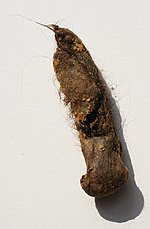| Revision as of 17:05, 12 November 2010 editAlansohn (talk | contribs)Autopatrolled, Extended confirmed users, Pending changes reviewers, Rollbackers505,096 editsm Reverted edits by 24.39.160.80 (talk) to last revision by Tórizs (HG)← Previous edit | Revision as of 05:37, 5 January 2011 edit undo165.228.57.39 (talk) →See alsoNext edit → | ||
| Line 9: | Line 9: | ||
| {{Clear}} | {{Clear}} | ||
| wow yuk cool sucks | |||
| == See also == | |||
| * ] | |||
| * ] | |||
| * ] | |||
| == References == | == References == | ||
Revision as of 05:37, 5 January 2011

A hairball is a small collection of hair or fur formed in the stomach of animals that is occasionally vomited up when it becomes too big. Hairballs are primarily a tight elongated cylinder of packed fur, but may include bits of other elements such as swallowed food. Cats are especially prone to hairball formation since they groom themselves by licking their fur, and thereby ingest it. Rabbits are also prone to hairballs because they groom themselves in the same fashion as cats, but hairballs are especially dangerous for rabbits because they cannot regurgitate them. Because the digestive system of a rabbit is very fragile, rabbit hairballs must be treated immediately or they may cause the animal to stop feeding and ultimately die due to dehydration. Cattle are also known to accumulate hairballs, but as they do not vomit, these are found usually after death and can be quite large.
Although uncommon in humans, some hairballs have been reported, often in young girls as a result of trichophagia, trichotillomania and pica. In 2003, a 3-year old girl in Red Deer, Canada had a grapefruit-sized hairball surgically removed from her stomach; and in 2004, an 18-year old woman from McAdam, Canada, had a 2.3 kg (5.1 lb) hairball surgically removed from her lower intestine. Hairballs can be quite hazardous in humans, since hair cannot be digested or passed by the human gastrointestinal system, and (assuming it is identified) even vomiting may be ineffective at removing the hair mass. This can result in the general impairment of the digestive system.
wow yuk cool sucks
References
- Hairballs: Myths and Realities behind some Medical Curiosities, National Museum of Health and Medicine, Washington, D.C.
- Girl died from eating her hair, BBC News, 1999-08-20
This veterinary medicine–related article is a stub. You can help Misplaced Pages by expanding it. |